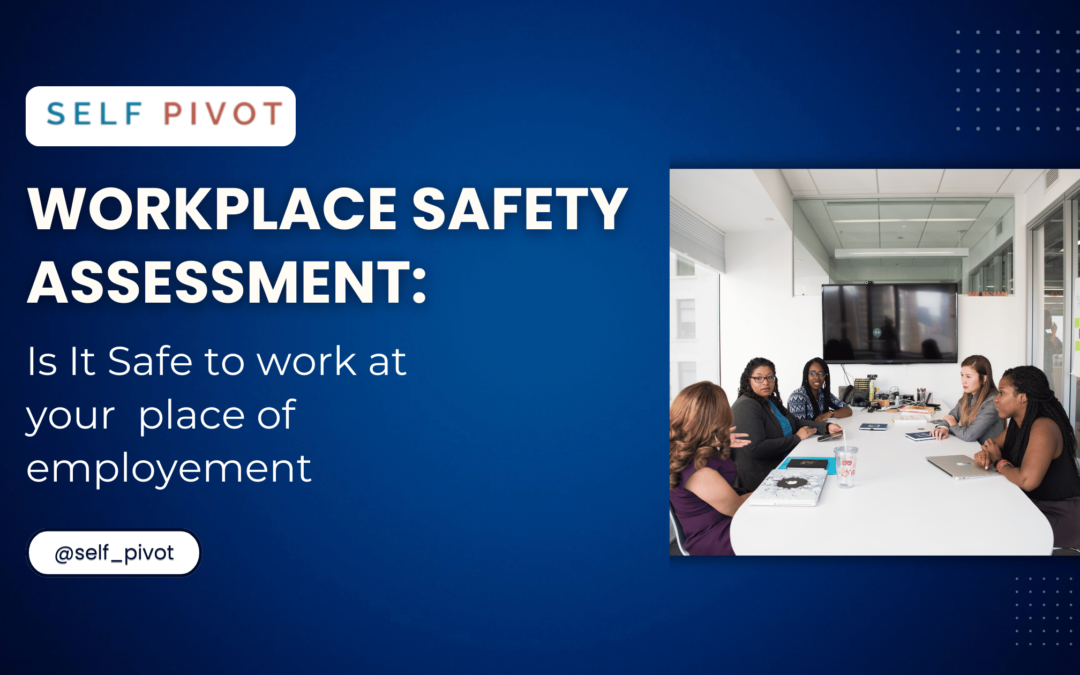Workplace Safety Assessment: ‘Ensuring safety is not just about checking boxes, but about creating an environment where everyone feels secure and valued
Going back to work after coping with personal or professional health problems can feel tough for anyone. In this blog article, “How to Tell If It’s Safe to Return to Your Place of Employment,” we’ll assist you in understanding the right time to return to your workplace. We will discover what to think about, like your mental and physical health, and a guide for making your comeback at work as easy as possible. If you are feeling overstrained by work or facing major health problems, this blog will help you make the right choices for yourself and be able to manage your stress.
This blog will help you understand whether it is safe to return to work and offer real guidance to verify your return is smooth and safer. If you have trouble deciding to go back to work when you are suffering from anxiety, this blog is a complete guide for you in making the right choice for your comfort and career.
Workplace Safety Assessment: Why Do You Feel Overwhelmed During the Work?
The Reason for feeling stressed at the workplace is due to a few things: Many tasks with little time, improbable hopes from your manager or associates, not getting appropriate resources or support, or, feeling of not having the required skills for the job.
Much workload in less time:
Working on a deadline to complete more tasks in some hours, can feel like a burden for anyone. The pressure of deadlines or too much workload can stress you out and make you distracted from your targeted work hence leading to burnout.
Too Much High Expectations:
If your boss or colleagues set goals that look hard to reach at a given time with fewer resources. This can be exhausting, draining, and depressing, especially when it feels like you’re trying hard to fulfill the goals that are set for you.
Less resources and support:
It’s hard to manage various projects in less time and without the exact tools, training, or assistance. Outdated technology and inadequate resources can make it almost impossible to reach your goals, resulting in stress or burnout.
Lack of required skills:
Only being qualified is not enough. Lack of experience or not having enough knowledge of new tools can be overwhelming. In such situations, seeking help from more experienced colleagues can reduce the stress.
Feeling overwhelmed at the workplace is a sign that causes stress and burnout, but with the right tactics and support, you can balance the work schedule and your mental health. Let’s discover these tips that can help you manage your work pressure and reduce stress.
Assuring Good Mental Health:
Circumstances like social anxiety or ADHD (Attention-Deficit/Hyperactivity Disorder)- can affect your work performance. Interaction with your boss about your perfect or ideal work environment can help you deal with these challenges.
The Interconnection Between Work Stress and Health Issues:
Let’s learn about the impact of work stress on physical and mental health in this blog.
The interconnection between work pressure and health issues is a complicated and important part of the study. We will discover how these two aspects affect each other:
Stress Response Methods:
When an employee has to face major tasks such as high productivity in less time of tight deadlines or struggles at work at that time, the stress response system activates in the body. This mechanism involves the release of stress hormones such as ‘cortisol’ and ‘adrenaline’. Though these response methods are helpful while tackling short bursts; chronic activation can cause numerous health complications. Workplace safety assessment helps spot any risks and makes sure the office is safe for you to return.
Physical Health Impact:
Heart Relevant Problems:
Long-time stress is allied with high blood pressure and increased scope of stroke and heart diseases. Stress hormones can cause heartburn, breathing difficulties, and inflammation, as well as other factors that harmfully affect heart health.
Digestive Issues:
Stress can lead to intense gastrointestinal issues such as (IBS)irritable bowel syndrome, ulcers, and acid reflux.
Weak Immune System:
Long-lasting stress can be the cause of weakening someone’s immune system and all these reasons make the individuals more vulnerable to infections and sicknesses.
Mental Health Impact:
Anxiety and Depression: Higher levels of work pressure are the main cause of increased rates of anxiety and depression. The constant strain and pressure can end up with mental health disorders.
Burnout:
This is a physical and emotional state, as well as mental fatigue caused by constant and excessive stress. Burnout often leads to a drop in productivity and a feeling of disinterest in work.
Behavior Changes:
Stress can lead to unhealthy behaviors in handling the situations such as taking excessive alcohol, smoking habits, or unhealthy eating habits. These irresponsible and unhealthy behaviors can additionally contribute to health complications and can lead to death too.
Sleep Disturbance:
Work stress can affect sleep patterns and can give you sleepless nights or insomnia. Poor quality sleep can worsen both mental and physical health issues.
Work-Life Balance:
Another cause of increased stress levels can be the poor work-life balance. Struggling to balance work demands leads to a stressful personal life and hurts health.
Work stress can be reduced through tactics for example: stress management, healthy lifestyle choices, and cooperative work environments to help lessen its effects on health. Contact us for our Online Counseling Services if you are feeling stressed at your workplace.
Workplace Safety: Psychological Safety Matters
Psychological safety is important for a pleasant and healthy as well productive workplace. A healthy workplace makes you feel confident for Instance: You won’t be penalized or mocked when you share your ideas, are curious about some queries, or admit mistakes. When a person feels safe to speak up in his work environment, it is helpful for everyone and leads to a healthy and joyful workplace.
A psychologically safe environment allows the team members to be willing to fully share their creative ideas, and fight with obstacles together in work. This honest approach helps to solve problems, improves creativity, and boosts team performance. It means the united team can solve any problem early because the comfort in the people leads to keeping anxieties away.
Without psychological safety, staff can feel disconnected, work less efficiently, and may think about leaving the company. They may hesitate to share their creative ideas or avoid solving the issues, which can prevent the company’s growth and innovation.
Maintaining psychological safety means building a culture of mutual respect and understanding between coworkers. Leaders play an essential part in this by promoting open communication and solving any issues that can be obstacles to support and betterment the environment.
Conclusion:
Workplace safety assessment is important to ensure the best time to return to the office is both confident and safe, protecting your health and peaceful state of mind.
Deciding to get back to work after facing health challenges can be the major step. This blog addresses important factors to help you determine whether you’re ready for work or not such as your psychological and physical health as well as work pressure is the factors for psychological safety.
By understanding these aspects, you can make an informed decision and be assured of a smoother transition. Effective strain management and a caring work environment are significant to your happiness and success. using the right dealing method, you can handle this transition and happily return to a healthy workplace. “See how personal and professional growth boosts workplace safety by reading our blog on ‘The Importance of Lifelong Learning.’

